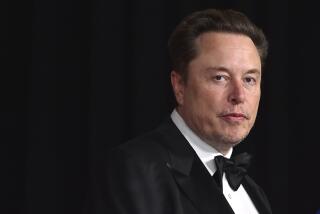Lockheed Has Powerful New Weapon: ESOP
Keep it in the family. Lockheed moved to avoid takeover Tuesday by putting $500 million worth of its stock into an employee stock ownership plan. That is, the big aerospace company is giving employees 17% of its stock so it canât be bought by predatory investors on the open market.
There are two trends evident in Lockheedâs restructuring. One is the forming of a merger wave, with aerospace-defense companies being forced to avoid takeovers the way other industries from airlines to supermarkets have had to do.
The other trend is use of the employee stock ownership plan, or ESOP, to deter investors a companyâs management deems unwelcome. Polaroid recently used its ESOP to foil a buyout bid from Shamrock Holdings, and on Tuesday, Tribune Co., owner of the Chicago Tribune, used its ESOP to buy stock and blunt the advance of investor Robert M. Bass, who has purchased an interest in Tribune.
The buyer Lockheed was trying to avoid is Harold C. Simmons, a highly successful investor who has built a $2-billion (revenues) conglomerate called Valhi Inc. by takeovers and investment gains. Simmons announced Monday that he had acquired 5.3% of Lockheedâs stock. The company wasnât thrilled and launched a restructuring--which includes sales of real estate and a subsidiary, plus a planned share repurchase--as a defense against Simmons.
âIâm disappointed, and Iâm considering selling some or all of my stock,â Simmons said Tuesday. In the past, Simmons has responded to management defensive tactics by redoubling his takeover efforts. But he seemed to be letting Lockheed go, with a swipe at the ESOP idea--âIf theyâre giving stock to the employees, thatâs obviously not good for the public shareholdersâ--and the explanation that heâd bought into Lockheed in anticipation of consolidation and mergers in the aerospace industry.
Tighter Competition
âThatâs part of it,â Simmons said. âItâs a combination of value (in Lockheedâs stock price) and consolidation. I think General Dynamics is attractive, and Rockwell and Raytheon, just to name three other companies.â
There are too many companies for too little business in aerospace these days, and the prospect is for years of shrinkage in defense budgets. In military aircraft, for example, the thinking among analysts is that seven plane makers will consolidate to four; that Grumman, Northrop and Rockwell may drop out of plane making, leaving the field to Lockheed, Boeing, McDonnell Douglas and General Dynamics. In a shrinking industry, some companies would become subcontractors, others would merge out of existence.
Itâs the kind of outlook that excites market speculators but could prove risky for ordinary investors. Itâs always chancy betting on takeovers--as witness Lockheed stock. It was selling at $46.75 on Monday when the news broke that Simmons had a 5.3% stake, and speculators, anticipating a takeover fight, sent it up $3 a share to $49.75. But on Tuesday, when the company announced its restructuring, speculators realized there would be no takeover and showed their disappointment by dropping Lockheed $2 a share to $47.75.
Ordinary investors donât need such gyrations, but they still can win if they buy on the fundamentals. In Lockheedâs case, theyâre not bad. The stock price is low--six times 1988 earnings--because Lockheedâs profits are expected to decline in 1989, according to analyst Suzanne Patrick of Sanford C. Bernstein & Co., a research firm. The C-5B transport program is phasing out and expenses continue for Lockheedâs entry in the advanced tactical fighter competition.
But profits are expected to rise again in 1990. Meanwhile, Lockheedâs mainstay, the Trident missile program is not threatened by defense budget cutbacks, and the company, in the words of one defense analyst, is âa treasure house of technology.â
Yes, but is Harold Simmons right? Does an ESOP benefit employees at the expense of public shareholders? No. The theory behind ESOPs--stock ownership plans devised in the 1930s by investment banker Louis Kelso--is that they benefit the business by increasing employee commitment to the firm. The practice of ESOPs has been criticized over the years, however. One objection is that ESOPs may not be good for employees because they concentrate too many eggs--job, salary and retirement savings--in one basket. (In Lockheedâs case, there is no such danger, as the ESOP is supplementary to a pension plan.) Also, the ESOP has been misused as a device for protecting managementâs power and prerogatives.
Yet the new use of the ESOP, to defend against takeovers, seems a direct extension of the original purpose. For, certainly, people who work for the company have more at stake in its long-term survival and stability than do most acquirers. In a world of quick-buck artists and bust-up takeovers, can it be bad for business to place ownership with people who have a real stake in the company? Some trends are healthy.
More to Read
Inside the business of entertainment
The Wide Shot brings you news, analysis and insights on everything from streaming wars to production â and what it all means for the future.
You may occasionally receive promotional content from the Los Angeles Times.








